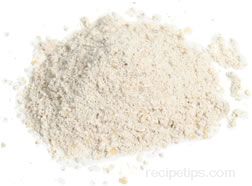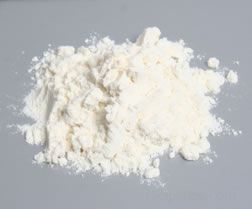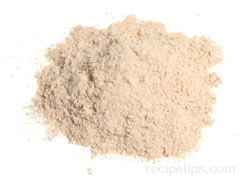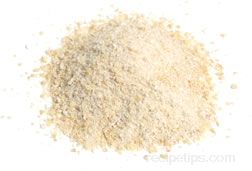When wheat flour is mixed with liquid, gluten is formed. Gluten is the substance that provides dough with elasticity and the ability to stretch as the leavening agent produces carbon dioxide gas, which enables the dough to rise effectively. This characteristic has resulted in the universal popularity of wheat flour varieties. The more protein in the flour (as is the case with hard wheat flour), the more gluten is formed when the flour is mixed with liquid. However, some recipes require that baked items not rise excessively, so using flour with less gluten forming capability (soft wheat varieties) is better for this purpose.
Wheat flour (especially all-purpose flour) is available in bleached and unbleached varieties. Bleaching is a process used by millers to quickly increase the whiteness of the flour. Over time, flour oxidizes and whitens naturally, but chemical agents are used to speed the process in order to eliminate the long waiting period that was traditionally required. It is required that flour treated chemically for the purpose of bleaching must be labeled “Bleached Flour.”
It is wise to use flours specifically formulated for various baked goods, such as bread flour or cake flour, although all-purpose flour is suitable for a majority of items. In fact, many recipes calling for wheat flour as an ingredient, suggest the use of an all-purpose flour, which is a heat processed, steel-ground blend of both soft wheat and hard wheat.
Bread flour is a variety of wheat flour produced from hard wheat, making it high in gluten and very effective for yeast bread while cake and pastry flours are made from a low protein, soft wheat, so the flour contains less gluten. This results in lighter, less dense textures (a tender crumb) for various cake and pastry items.
Enriched flours are those that have been processed from grain to remove the amino acids and nutrients, bleached to whiten the appearance, and then reformulated with nutrients, such as thiamin, riboflavin, niacin, Vitamin D, iron, and calcium added in accordance with established government guidelines. Enriched flour does not contain the bran or germ, so it is necessary to add nutrients.
Instant flour is a type that dissolves easily in liquids that range from cold to hot in temperature. This type of flour is most often used when gravies, sauces, soups, and other food items require thickening.
Gluten flour is the type most often used as an additive for varieties of flour that are low in gluten. It is made from hard wheat and has been processed to remove the starch so that the gluten content is of a higher proportion.
Self-rising flour is all-purpose flour that has been processed by adding salt and baking powder (leavening). It can be easily prepared at home by adding 1½ teaspoons of baking powder and a ½ teaspoon of salt to 1 cup of all-purpose flour.
Whole-wheat flour refers to flour made from the entire kernel of wheat, which includes the bran and germ. This creates flour that is more nutritious for baked goods. Whole-wheat flour may also be referred to as graham flour (although there are some differences) or entire wheat flour.
Graham flour, named after the Rev. Sylvester Graham who developed the flour, is a type of wheat flour that is slightly coarser than regular flour. The flour is often confused with standard whole-wheat, but there are some differences. In Graham flour, coarsely ground flakes of bran are added and the wheat germ is usually removed to lengthen the shelf life of the flour. Graham flour is most often used in the production of Graham crackers.
2. To dust or spread a light coating of fine ground flour over a surface, a utensil, a pan, or a food in order to prevent items from sticking together or to create a browned surface on foods during a cooking process. For example, to prevent dough from sticking to a surface on which it will be worked, flour is spread on the work surface to prevent the dough from sticking as it is rolled and kneaded. Coating foods with flour prior to frying helps to create a golden brown surface on the food as it fries. Some ready-to-eat foods, such as candied fruits, are also coated with flour to keep them from sticking together.


















